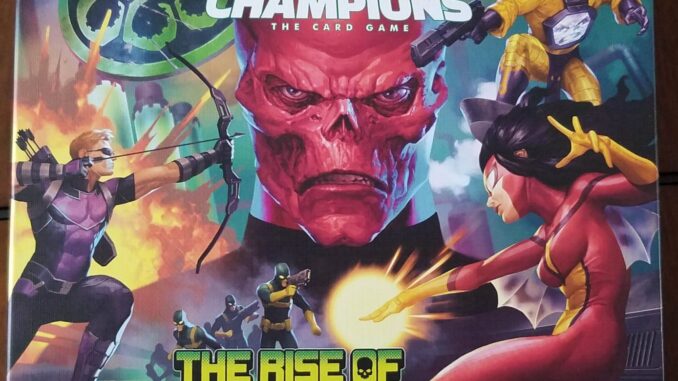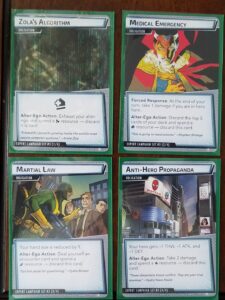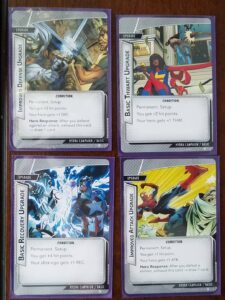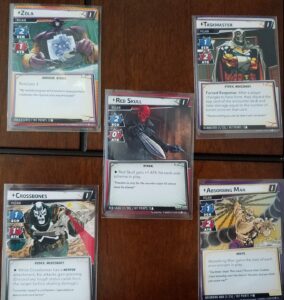
Last month we took a look at Marvel’s Champions game and we’re going to follow up on it with a look at the first big-box expansion, The Rise of Red Skull. The idea behind this expansion is Red Skull has assembled a group of baddies to carry off an evil plan involving the Reality Stone. It introduces the first Campaign to the game, along with five villains and two heroes that can also be used for regular game play.
Campaign- A
The campaign mode is new for Champions. Instead of playing stand-alone missions, you take a group of heroes along five encounters, one each against the boxes five new villains. If you win you move onto the next mission. If you lose, you just try again later. You must play the same hero in each consecutive mission but you are free to switch out your deck and even change aspects entirely.

When you start, you have a choice between two modes to play; standard and expert. In standard mode, games are essentially the same as regular games. In expert mode, your hero starts the next game with the health they have at the end of the previous mission. Skirt by with 1 health and you’ll be in a tough spot during the next game. You also have the option to fully heal before the next mission but it comes with a cost. There are four Obligation cards which can be added to your Hero deck. When these cards are draw you immediately play them. They get progressively more nasty so if you end up adding all four to your deck, you’re in for some trouble.

To balance this, the campaign also adds upgrades to your heroes after each mission. The first mission gives you a set of cards that can only be used in one game but provide quite a powerful effect. They start in play and once you use the ability, they remain in your deck for that game, so could be used again. But they are removed in future missions. If you can hold on to them until you face Red Skull in the finale, good for you.
Other missions add in new Allies that have a zero cost to play which is incredibly handy. And they are very strong in their own right. They would be unbalanced in the regular game, auto-includes, so it’s good you don’t get to keep them. But they will still show up whenever you play Task Master.
The final mission reward is a permanent upgrade that gives your hero bonus stats. There’s a +1 to Thwart, Attack, Defense and Recovery. Each also add extra hitpoints. Further, if you complete certain objectives these can be flipper to the advanced side which also add a special ability.
These upgrades will all come in handy in the final fight against Red Skull. Another thing the campaign does is track how well you did against each villain. All this comes into play when you fight the Big Bad at the end. You’ll need all the extra upgrades you can get to succeed in this fight.
Villains- B+

The box comes with five new villains you can play in the campaign or standalone. Each has its own deck which can be modified with different modular encounters in standard play. They also have a unique gimmick which affects how they play and how you play against them.
I wasn’t a fan of Crossbones, as his gimmick revolved around adding more and more upgrades on himself. This led to him reaching crazy heights of power. That’s something you have to manage to succeed. One thing I didn’t like was the almost permanent Pierce he gains thanks to his abundance of weapons. I like Pierce as a game mechanic. But as an ability attack, not the standard every attack. This entirely negated the Tough mechanic, making it a pointless aspect. Now, it’s not a huge deal and maybe important to balancing out Dr. Strange abundance of Toughs.
The other part of Crossbones I didn’t care for was the abundance of Schemes. There are several, so failing one doesn’t end the game. But because there are so many, the amount of Threat Crossbones needs to complete it are quite low. This resulted in him going from zero threat to complete on a few stages in more than one game. Not much your heroes can do when that happens. Fortunately, that didn’t happen on the final stage, as that would be an unfun way to lose a game. Failing to manage it and losing is your own fault. Losing because of a bad card draw that you have no control over just sucks.
Absorbing Man felt meh the first play through but I see a lot of potential in him. His changing dynamic with his power led to constantly needing to check what he did, which keeps things fresh but also gets a little annoying. Our first adventure was on standard and we’re about to get to him on Expert so this should prove more of a challenge.
Taskmaster’s damage to heroes when they flip was a real challenge for characters that like to flip a lot. Wouldn’t want to face him as She-Hulk. This was another mechanic that alters your standard tactics, as the goal of flipping is to recover. So if you choose to flip to Alter-Ego, you’ll need to spend several turns there in order to recover and mitigate the damage you’ll take when returning to Hero form.
I quite liked Zola. His death from a thousand cuts required me, playing a beefy Protection Captain America, to rethink my game. Five defense didn’t mean much but it made Ally’s defending more interesting. Suddenly, guys like Luke Cage could potentially defend against three or four attacks over their lifetime.
Red Skull brings elements from the previous encounters together. How well you did against Absorbing Man will affect starting Threat and your success against Zola’s minions will play a roll as well. His main schtick is Side Schemes. If you’re not built to handle those well, you’re going to have a bad time. He was a fun encounter and the side schemes being their own deck was a nice change. He could be a real challenge with certain modular encounters though. It was also kind of cool that his side schemes often gave you a benefit when they were defeated.
Heroes- A
Since she hasn’t appeared in a movie or live-action show, I was completely unfamiliar with Spider-woman going into this box. Still don’t really know her story. But mechanically, she’s loads of fun to play. The mechanic of gaining power from different aspect cards, combined with her ability to take two aspects in her build really give her a unique flavor. She excels at low cost aspect cards so you can maximize the turns you are playing multiple aspects in a round. Those turns you can pull off all four aspects and use a Self-Propelled Glide to activate yourself twice is bonkers fun. Having the combo of aspects also leads to unique combos of cards.
Hawkeye feels more in line with other characters, such as Captain America, Iron Man, and Black Panther which rely on essential upgrades. His diversity of arrows gives him lots of approaches he can take to deck building. He can be quite heavy on the offense and really can turn into a glass cannon with Aggression. His main downside is the inability to take the Hawkeye ally which is a very handy one to have in a Leadership deck against a minion heavy bad guy.
His Alter-Ego ability to recover his bow is very powerful. In one game, as Captain America, I had to discard my shield on the first round, meaning it was out of the game for an entire run through my deck. It also happened that the first time I played Thor, I had Mjolnir drawn as the opening Ultron Drone meaning he also lost the hammer as well. But Hawkeye can just get his Bow back by flipping over.
Conclusion- A
This is an essential purchase if you enjoy Champions. $40 for 7 characters and villains is a good bargain on its own. The campaign is a lot of fun and gives the game a great new type of play. I hope to see more campaigns coming, hopefully with the Guardians box next year.
Wayne Basta
Latest posts by Wayne Basta (see all)
- X-Wing Tier List – Rebels - May 10, 2023
